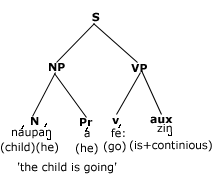acts.
A statement may again have two manifestations, a positive
statement or a negative statement. Hmar manifests all
these. |
As
stated in the course of the discussion a simple sentence
in Hmar consists of a VP alone or a combination of an
NP and VP. It is, therefore, necessary to look at the
phrase structure of NPs and VPs i.e. how NPs and VPs
in Hmar are made up of. |
|
If
a simple sentence in Hmar is dissected into subject
and predicates slots the subject slot is obviously represented
by a noun phrase, in short, and NP. The predicate slot,
on the other hand, is represented by a large verb phrase,
in short, a VP, which again may consist of an NP+ a
VP. Thus, a simple sentence in Hmar is essentially made
up of one or more NP (s) and one VP. The analysis of
the syntactic structure of a sentence is nothing but
the analysis of the structures of constituent phrases. |
|
An
NP, either in the subject slot, or, in the object slot,
may consist of a noun alone. In the sentence given below. |
 |
the
NP in the subject slot is represented by /náupá /
‘boy’ alone. The NP could be expanded by adding another
constituent such as a demonstrative pronoun. It may
be noted that demonstrative pronouns in Hmar show a
peculiar behavior; they occur in duplicate, once before
the nouns and then after the nouns. When one wants to
use a demonstrative pronoun, i.e. /s /
‘boy’ alone. The NP could be expanded by adding another
constituent such as a demonstrative pronoun. It may
be noted that demonstrative pronouns in Hmar show a
peculiar behavior; they occur in duplicate, once before
the nouns and then after the nouns. When one wants to
use a demonstrative pronoun, i.e. /s /
‘that’, the above sentence will obtain the form such
as given below : /
‘that’, the above sentence will obtain the form such
as given below : |
 |
 |
Thus,
an NP consisting of any demonstrative pronoun (dp) would
have a structure such as /dp-N-dp/. |
| 4.1.1.2 |
It
is possible to have further expansion of this
NP by adding a further constituent such as an
adjective. As encountered before, the rightful
position of an adjective in an NP is just after
the noun. When one wants to add another constituent
/ìnsá: /
‘tall’ to the above NP it would appear as under: /
‘tall’ to the above NP it would appear as under: |
|
 |
|
|